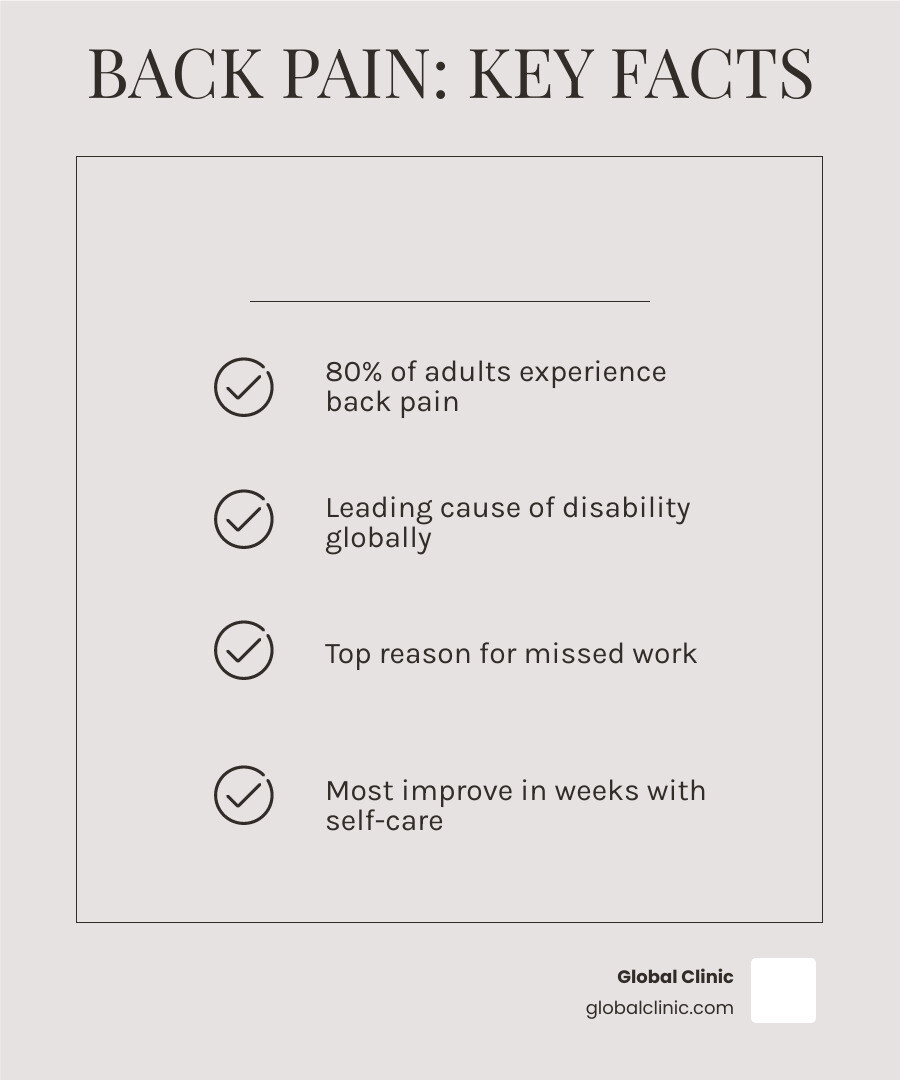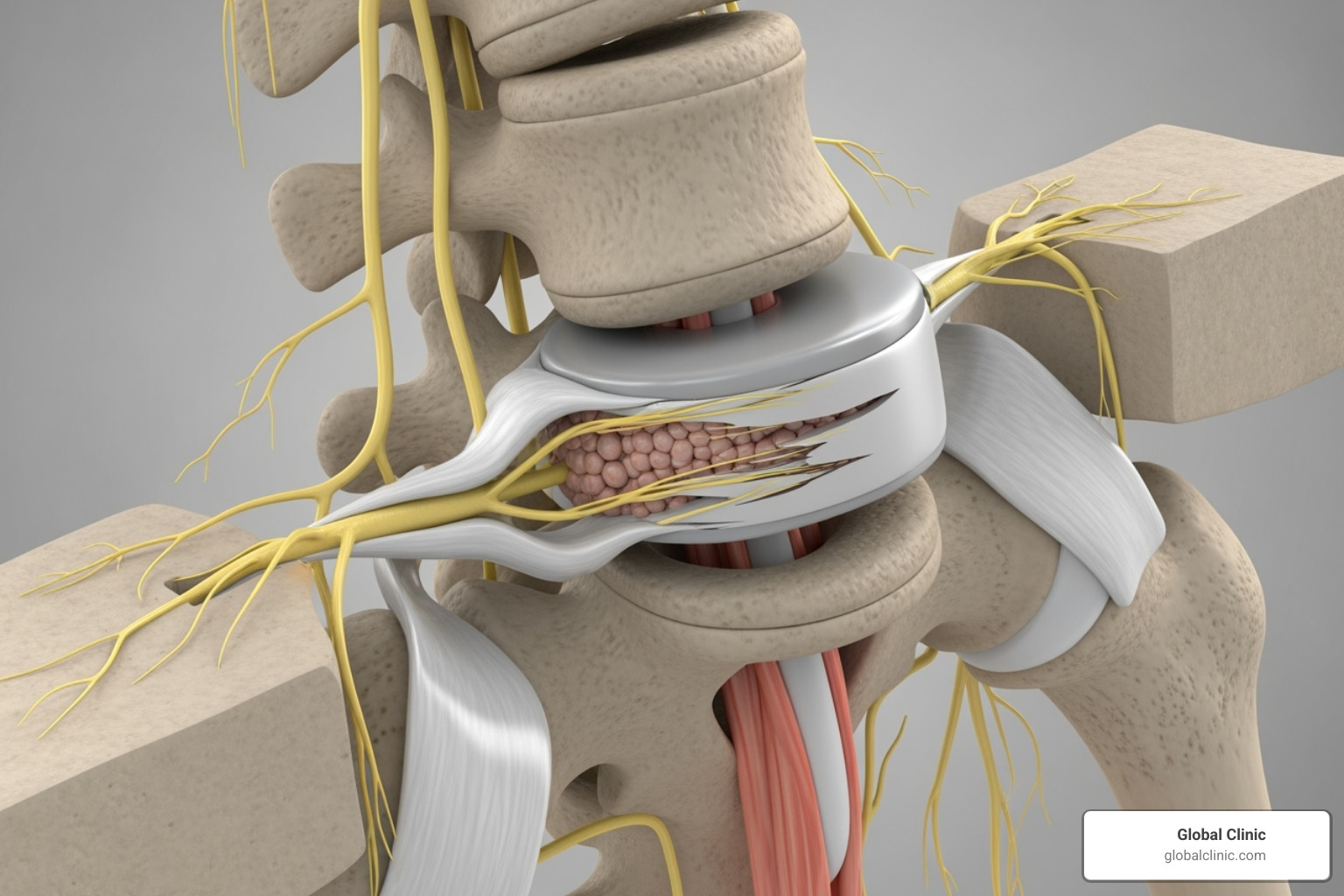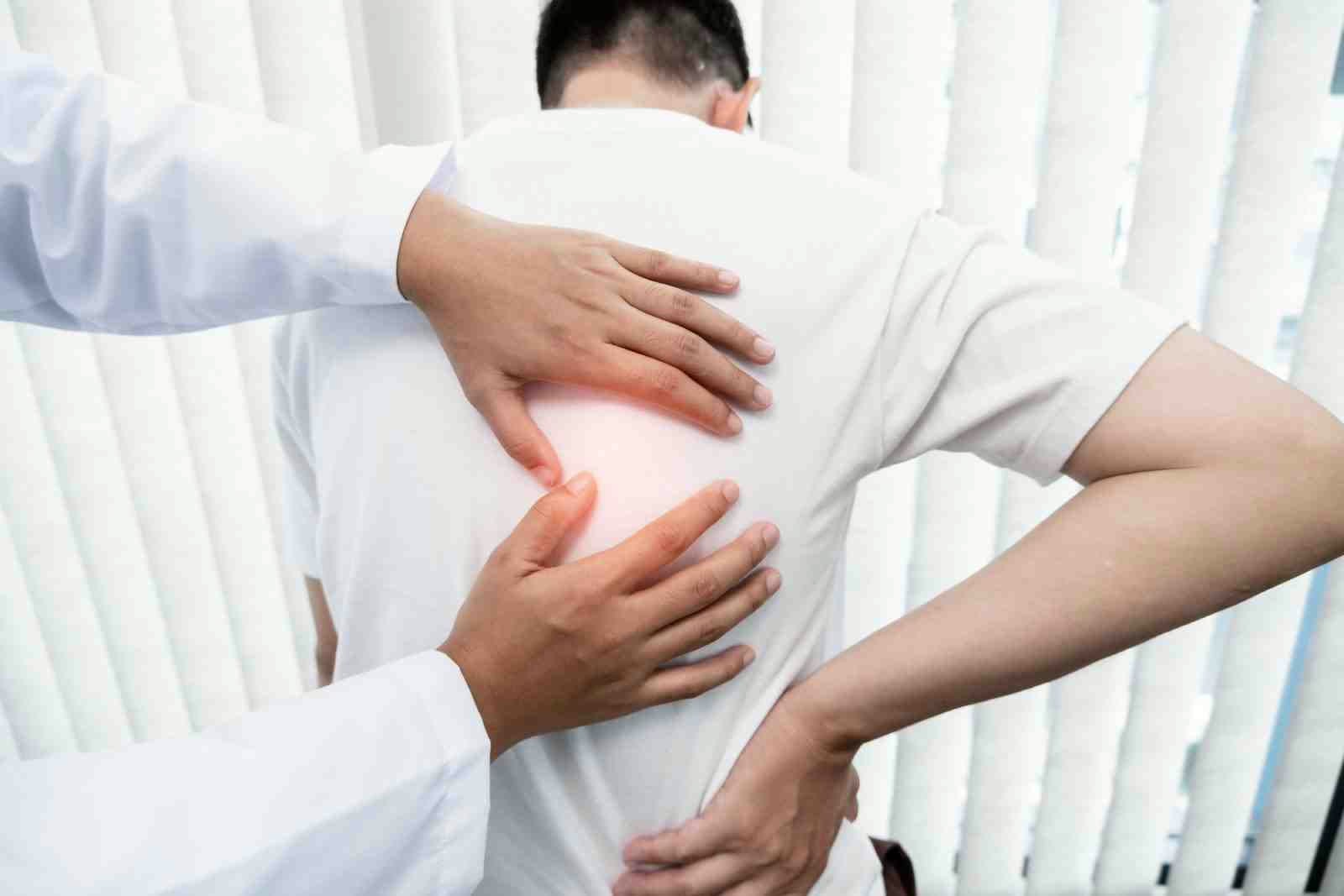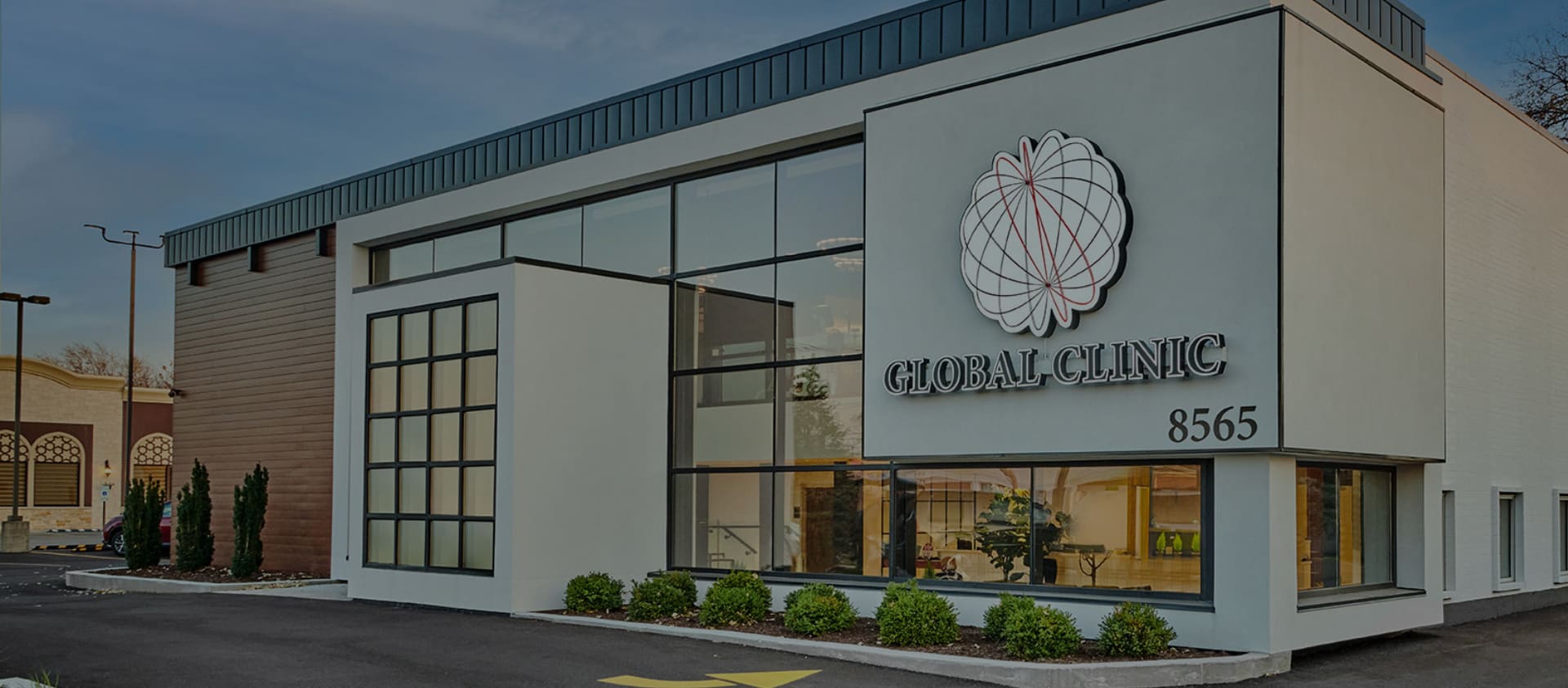Understanding the Pervasiveness of Back Pain
The back ache cause is a universal health concern, affecting nearly everyone at some point. As the leading cause of disability worldwide, it’s the most common reason people miss work or seek medical attention.
Most Common Back Ache Causes:
- Muscle strains and ligament sprains – from improper lifting or sudden movements
- Poor posture – especially from prolonged sitting or computer work
- Herniated or bulging discs – when disc material presses on nerves
- Arthritis and age-related changes – wear and tear on spine joints
- Weak core muscles – inadequate support for the spine
- Excess weight – added stress on back structures
- Sedentary lifestyle – lack of movement weakening back muscles
The good news is that most back pain improves within a few weeks with self-care. However, understanding the root of your discomfort is key to finding lasting relief and preventing recurrence.
Whether you’re dealing with a dull ache or sharp, shooting pain, identifying the cause helps determine the most effective treatment. Some issues are simple mechanical problems, while others may need professional intervention.
As Ana Vinikov from Global Pain & Spine Clinic, I’ve spent over 20 years helping patients in Northern Chicago identify and treat the underlying back ache cause with non-surgical approaches. A personalized treatment plan starts with understanding your specific pain.

Back ache cause definitions:
Decoding Your Pain: Symptoms and Types of Back Ache
Understanding the nature of your discomfort is the first step in identifying the back ache cause. Your body sends messages through various symptoms, and learning to decode them is crucial for effective treatment.
How Back Pain Feels: From Dull Aches to Sharp Sensations
Back pain can manifest in many ways: a dull, persistent ache, a sharp, stabbing sensation, or a burning or shooting pain that may signal nerve irritation. You might also experience muscle tightness, stiffness, or sudden spasms.
Pay close attention to symptoms like tingling, numbness, or weakness in your legs, as well as radiating pain that travels from your back to your buttocks or down your leg (a hallmark of sciatica). These are important clues that help pinpoint the cause. The timing of your pain—whether it’s worse in the morning or after sitting for hours—also provides valuable information.
Categorizing Back Pain by Duration and Location
Healthcare providers categorize back pain by its duration and location to help diagnose the issue.
By Duration:
- Acute back pain lasts less than four weeks and often results from a specific injury. Most cases resolve with self-care.
- Subacute back pain persists for four to 12 weeks and may require more focused conservative treatment.
- Chronic back pain continues for more than 12 weeks. While more complex, it rarely signals a dangerous condition.
By Location:
- Lower back pain is the most common, affecting over 80% of people. The lumbar spine bears most of the body’s weight, making it susceptible to injury.
- Upper and middle back pain (thoracic spine) is less frequent and often linked to poor posture from hunching over a desk or repetitive movements.
The Primary Back Ache Cause: Mechanical, Structural, and Lifestyle Factors
For most people, the back ache cause is mechanical, related to how the spine, muscles, and ligaments function, often influenced by daily habits.
Common Mechanical and Structural Problems
These issues directly affect the physical components of your back and are the most frequent reasons for pain.

- Muscle strains and ligament sprains are the most common culprits. They often result from improper lifting or sudden twisting, causing pain that worsens with movement.
- Herniated discs occur when a disc’s soft center pushes through its exterior, potentially pressing on nerves. This can cause sharp, radiating pain (sciatica), numbness, or weakness.
- Bulging discs are a less severe version where the disc bulges without rupturing but can still pressure nerves.
- Degenerative disc disease is a normal part of aging where spinal discs thin out, reducing cushioning and potentially causing pain.
- Arthritis of the spine includes Osteoarthritis (cartilage breakdown) and Ankylosing spondylitis (an inflammatory condition). Sacroiliitis, inflammation of the sacroiliac joints, also causes lower back pain.
- Spinal stenosis is a narrowing of the spinal canal that puts pressure on nerves, often causing leg heaviness that worsens with walking.
- Spondylolisthesis is when one vertebra slips over another, while Scoliosis is an abnormal spinal curve. Both can cause pain, especially with age.
- Piriformis syndrome involves a buttock muscle irritating the sciatic nerve. Sciatica itself is a symptom—radiating pain along the sciatic nerve—often caused by a herniated disc. For more details, see our guide on Piriformis Syndrome vs. Sciatica.
Lifestyle Habits as a Frequent Back Ache Cause
Our daily routines play a huge role in back health. The good news is that these factors are often the easiest to change.
- Poor posture: Hunching over a computer or slouching places undue stress on your spine, leading to stiffness and pain. This is supported by scientific research from Harvard Health.
- Sedentary lifestyle and weak core: Prolonged sitting and lack of movement weaken back and core muscles. Your core acts as a natural brace for your spine; when it’s weak, your risk of injury increases.
- Excess weight and obesity: Extra weight, especially around the midsection, shifts your center of gravity and puts constant strain on your back.
- Improper lifting techniques: Bending at the waist or twisting while lifting can cause acute back injuries. Always lift with your legs, not your back.
- Smoking: Nicotine restricts blood flow to spinal discs, accelerating their degeneration and impairing healing.
- Psychological stress: Stress, anxiety, and depression cause chronic muscle tension and can amplify your perception of pain.
When Back Pain Signals a More Serious Condition
While most back pain is not an emergency, certain symptoms are red flags that signal a more serious issue requiring immediate medical attention.
Red Flag Symptoms: When to See a Doctor Immediately
If you experience any of the following with your back pain, seek help right away:
- Loss of bowel or bladder control: This can indicate cauda equina syndrome, a serious condition requiring emergency treatment to prevent permanent nerve damage.
- Numbness in the groin area: Also known as “saddle anesthesia,” this is another key sign of cauda equina syndrome.
- Severe leg weakness: Sudden difficulty standing or walking suggests serious nerve compression.
- Unexplained weight loss: Combined with back pain, this can point to underlying conditions like an infection or tumor.
- Fever with back pain: Could signal a spinal infection that requires prompt medical evaluation.
- Pain after an injury or accident: Falls or car accidents can cause fractures or other serious injuries that aren’t immediately obvious. Learn about the benefits of physical therapy after a car accident.
- Pain that worsens at night: Pain that disrupts sleep or gets worse when you lie down is not typical for mechanical back pain and should be checked.
Underlying Medical Conditions as a Back Ache Cause
Sometimes, back pain is a symptom of another medical issue.
- Inflammatory conditions: Ankylosing spondylitis and sacroiliitis cause chronic inflammatory pain that typically worsens with rest and improves with movement.
- Infections: Though rare, infections like osteomyelitis (in the bone) or spinal epidural abscesses can cause severe, persistent pain, often with a fever.
- Referred pain: This is pain felt in the back but originating elsewhere. Examples include kidney stones (sharp side pain), endometriosis (cyclical lower back pain), and pancreatitis (upper abdominal pain radiating to the back).
- Osteoporosis: This disease weakens bones, making them prone to vertebral compression fractures, which cause sudden, severe back pain.
- Spinal tumors: Very rare, but can cause a deep, aching pain that is often constant, worsens over time, and doesn’t improve with rest.
Finding the Cause and Path to Relief
Once a proper diagnosis identifies your back ache cause, a targeted plan can be created to address the root of the problem, not just the symptoms.
How Doctors Diagnose the Cause of Back Pain
Figuring out your specific back ache cause is a systematic process.
- Physical Exam & Medical History: Your provider will watch how you move, test your strength, and ask detailed questions about your pain, lifestyle, and medical history to gather crucial clues.
- Imaging Tests: While not always needed, tests like X-rays (for bones), MRIs (for discs and nerves), and CT scans are valuable when pain persists or red flags are present.
- Other Tests: Nerve studies (EMG) can pinpoint nerve compression, while blood tests can help identify inflammatory conditions or infections.
Effective Treatment and Management Strategies
At Global Clinic, we believe in combining effective approaches for lasting relief.

- Home Remedies: Initial relief often comes from heat and ice therapy and over-the-counter medications. Contrary to old advice, gentle movement like walking is better than prolonged bed rest for most back pain.
- Physical Therapy: A cornerstone of treatment, PT uses specific exercises to strengthen core muscles, improve flexibility, and correct harmful movement patterns. Addressing back pain with physical therapy is often the most effective long-term solution.
- Chiropractic Care: Focuses on restoring proper spinal alignment and joint function through gentle adjustments to relieve nerve irritation and muscle tension. Many patients find 4 ways chiropractic care can transform your life.
- Massage Therapy: Addresses the muscle tension component of back pain by improving blood flow, releasing tight muscles, and promoting relaxation.
- Injections: For persistent pain, targeted injections like epidural steroids can deliver anti-inflammatory medication directly to the source of irritation.
- Surgery: A last resort for less than 5% of patients, considered only for severe structural problems that don’t respond to extensive conservative care.
Proactive Prevention: How to Protect Your Back
Simple lifestyle adjustments can dramatically reduce your risk of back pain.
- Regular Exercise: Focus on core strengthening, low-impact aerobics (walking, swimming), and flexibility (stretching, yoga).
- Maintain a Healthy Weight: Reduces mechanical stress on the spine.
- Good Posture & Ergonomics: Sit and stand properly. Use supportive chairs, set up your workspace to avoid strain, and take frequent breaks from sitting.
- Proper Lifting: Bend at your knees, keep your back straight, and hold objects close to your body. Never twist while lifting.
- Quit Smoking: Improves blood flow and nutrient supply to your spinal discs, aiding in their health and healing.
Frequently Asked Questions about Back Ache Causes
Over my 20 years of practice, certain questions about the back ache cause come up frequently. Here are the answers to the most common concerns.
Can stress and anxiety really cause back pain?
Yes, absolutely. Psychological stress leads to chronic muscle tension in the back, neck, and shoulders. This sustained tension causes stiffness, fatigue, and eventually pain. Furthermore, stress and anxiety can heighten your brain’s perception of pain, making you more sensitive to discomfort. Managing stress is a key part of managing back health.
Is bed rest the best thing for a back ache?
No, for most common back pain, prolonged bed rest is not recommended. Gentle activity, like walking, is far more beneficial. Movement helps maintain flexibility, promotes blood flow to injured tissues, and prevents stiffness. In contrast, too much rest can lead to increased stiffness and muscle weakness, which can slow down your recovery.
What is the single most common cause of lower back pain?
The most common back ache cause is muscle strains and ligament sprains. These injuries typically result from overstretching the soft tissues in your back, often through improper lifting, a sudden awkward movement, or the cumulative effect of poor posture over time. While these strains usually heal, it’s crucial to address the underlying habits that led to the injury.
Conclusion: Taking Control of Your Back Health
Understanding your back ache cause is the first step toward taking control of your health. The encouraging truth is that most back pain stems from mechanical issues and lifestyle habits that you have the power to change.
By recognizing your pain patterns and knowing when to seek medical attention for red flag symptoms, you can make informed decisions about your care. Prevention is your best defense: regular exercise, good posture, proper lifting, and maintaining a healthy weight can dramatically reduce your risk of developing back problems.
For residents in Northern Chicago ready to take a comprehensive approach to their back health, the experienced team at Global Clinic has developed personalized care plans for over 20 years. We combine the best of physical therapy, chiropractic care, and other innovative treatments to address the root of your pain.
Don’t let back pain continue to limit your life. Take that first step toward lasting relief by learning how our team can help you find relief by addressing your back pain with physical therapy. Your back will thank you for taking action today.


